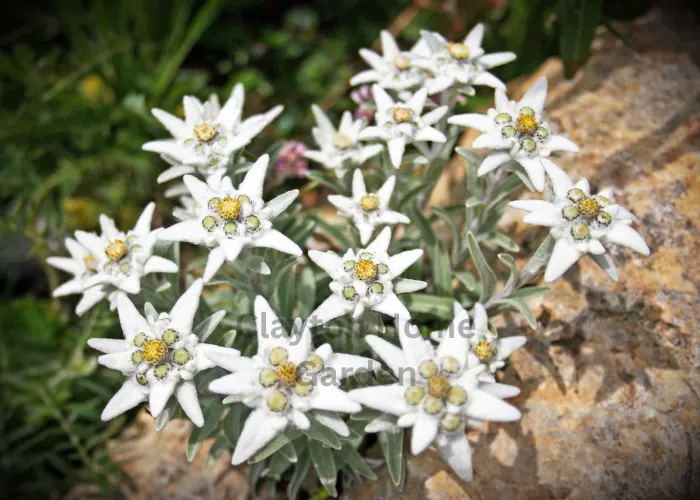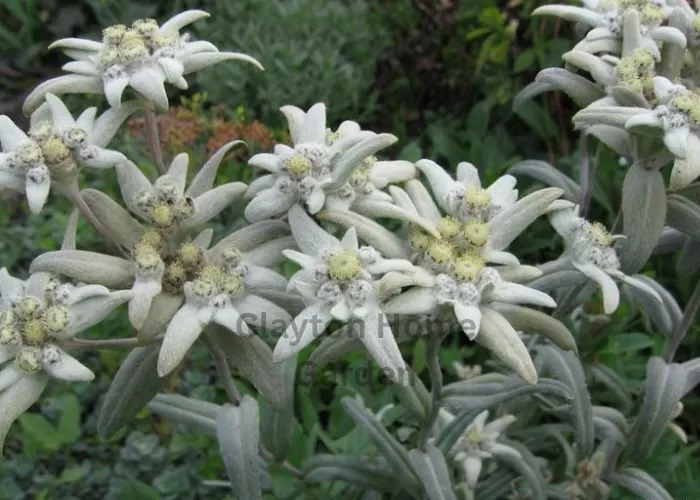How to Grow and Care for Edelweiss Flower: A Complete Guide

Edelweiss is one of the flowers that immediately brings to you the rugged nature that is the Alps. The small, beautiful white flower is more than simply an ornamental flower – it’s a symbol for pureness as well as strength and endurance. Since the beginning of time people have been admiring this flower because of its capacity to flourish in tough and mountainous conditions. If you’re thinking of the addition of Edelweiss to your landscape or putting in containers it’s an experience. If properly cared for this perennial that is hardy will bring elegance and beauty to your garden for a long time.
This guide will take you through all you should know about cultivating and taking care of Edelweiss from the beginning of planting to irrigation, soil requirements and propagation. Let’s take a look and discover how to care for this fabled flower.
What is Edelweiss?
Edelweiss (Leontopodium alpinum) is a perennial plant known for its white star-shaped petals, which are surrounded by a yellow center. It’s usually found in the high-altitude regions of Alps, Carpathians, and Pyrenees. Its name “Edelweiss” comes from the German words”edel” (noble) and”weiss” (white) in reference to the flower’s pure, snowy appearance.
Apart from its stunning beauty, Edelweiss holds deep cultural significance, particularly for Austria and Switzerland in which it is seen as to be a symbol of national pride. It is a symbol of strength and resilience and thrives in the toughest mountains.
|
Common Name |
Edelweiss |
|
Botanical Name |
Leontopodium alpinum |
|
Family |
Asteraceae |
|
Plant Type |
Perennial |
|
Mature Size |
6-12 in. tall, 8 in. wide |
|
Sun Exposure |
Full, partial |
|
Soil Type |
Well-drained |
|
Soil pH |
Neutral |
|
Bloom Time |
Spring, summer |
|
Flower Color |
White |
|
Hardiness Zones |
4-7 (USDA) |
|
Native Area |
Asia |
Symbolism of Edelweiss
Edelweiss does not just represent a bloom, it’s a symbol for the purity of life, endurance and courage. The association of the flower with the Alps in the Alps, where it thrives in a rugged landscape, is an emblem of the uncompromising beauty of nature’s beauty. In the 20th century, in the midst of World War II, the flower was linked with The Edelweiss Pirates, a resistance group from Nazi Germany. In the present, Edelweiss continues to be valued as a symbol for strength and endurance.
Edelweiss: Origin, Flowering Time, and Properties
Edelweiss is a native of the mountains of Europe which is where it has evolved to endure extreme conditions, such as extreme sunlight, frost, and soils that are poor. The flowers usually bloom between May through August but the exact time depends on the climate in your area. While it’s durable, Edelweiss is also quite delicate in appearance, with its white, silvery petals that give a distinct, almost ethereal appearance.
One of the main reasons Edelweiss is an adored flower is its capacity to thrive and bloom in harsh environments, making it an absolute survivor in the natural world.
Edelweiss Species and Varieties
Edelweiss isn’t a standard flower. Different types and kinds have emerged each with distinct characteristics. Here are some of the most popular:
Alpine Edelweiss (Leontopodium alpinum)

The most popular species, native in the Alps. It’s perfect for alpine gardens and cooler climates.
Alpine Edelweiss ‘Matterhorn’
A compact hybrid that includes smaller flowers, ideal for small-sized gardens or containers for gardening.
The Alpine Edelweiss “Montblanc
Montblanc” is a favorite for its larger stature and more hefty flowers, ideal for display and arrangements for flowers.
Chinese dwarf Edelweiss (Leontopodium souliei)
This less invasive cultivar can tolerate slightly warmer temperatures, which makes it a perfect choice for container gardening in areas with milder climates.
Each variety has specific requirements for care It’s crucial to determine the type you’re attempting to cultivate to ensure it has the greatest chance of success.
How to Plant Edelweiss
Growing Edelweiss requires some concentration However, it’s not that difficult to do if you follow the correct steps.
Timing
The ideal timing to begin planting Edelweiss is in the springtime, when the final frost is been cleared. If you reside in a climate with cold winters, you could begin to plant Edelweiss seeds indoors between 8 and 10 weeks prior to the last date for frost. Once your seedlings are established to be hardened off, you can gradually exposing them outdoors conditions prior to transferring them into your garden.
Location and Sunlight Requirements
Edelweiss is a favorite in the full sunlight. It is accustomed to the intense sun that is located in mountain environments Therefore, it is recommended to choose a place with six to eight hours of direct sun each day. Particularly hot climates, a little of shade in the afternoon can help keep the plant from becoming too stressed.
Soil Requirements
Edelweiss prefers soil that drains well and is slightly acidic, having pH between 6 to 7.5. Edelweiss isn’t a good choice for dense, waterlogged soils which could cause roots to decay. When your soil’s heavy on clay make drainage better by mixing in gravel or sand. Pots or raised beds with well-drained soil are ideal for garden soil that doesn’t satisfy these requirements.
Planting Distance
Place your Edelweiss plants 6-8 inches apart so that you can give the plants to expand and to promote air circulation. This can help in preventing fungal infections that are more prevalent when there is a lot of activity.
Watering Edelweiss
Edelweiss requires consistent water however, like other species of mountain vegetation, it does not want to be sat in water for long periods of time. It is recommended to water the plants thoroughly each week, making sure that the soil is dry between the waterings. The excess watering or allowing soil to become soggy could result in root rot. If you’re planting Edelweiss inside pots make certain that the container has adequate drainage.
Edelweiss Care: Daily and Seasonal Maintenance
After your Edelweiss is established, the it is important to take care of it properly to ensure it grows each year.
Fertilization
Edelweiss isn’t a big eater, so a bit can go a long way. A well-balanced, slow-release fertilizer, applied in the springtime will supply enough nutrients for healthy growth. A lot of fertilizer can cause less blooms and weaker growth. It is recommended to exercise a bit of caution.
Pruning and Deadheading
When the flowers are fading they’re a good idea to cut off the dead flowers. This helps the plant grow and produce more flowers, while keeping it neat. In the spring and summer Remove any dead or yellowing leaves to keep the appearance of your plant and to keep it from developing disease. In the event that your Edelweiss plant grows too tall or has grown too tall, gentle pruning can help keep it small.
Winter Care
Although Edelweiss is cold-hardy, and able to withstand cold temperatures, it will benefit from a little protection during winter. In the late fall, put mulch at the plant’s foundation to shield the roots from frost and extreme cold. If you live in areas that have extremely cold winters, it is worth considering using a cloche or row cover to offer additional protection.
Is Edelweiss Hardy?
Edelweiss is extremely durable and is able to withstand hardiness zones 4-7. It can stand up to freezing temperatures and heavy snow as well as the intense sunlight that is common at higher altitudes. However, in order to ensure that your plant is in good health, you need to ensure it’s well-drained soil in order to avoid the rot of roots in moist conditions.
Edelweiss Propagation
Edelweiss may be propagated by cuttings or seeds, based on your preferences.
Seed Propagation
To establish Edelweiss from seed, plant the seeds in the greenhouse about 8 to 10 weeks prior to the final frost. Make use of a seed-starting mix that is well-drained and gently press the seeds in the dirt. Keep the tray in a sunny, cool area and gently water. When the seedlings have grown enough, you can harden them off and then transplant them into the garden or pots.
Propagation by means of Cuttings
You can also grow Edelweiss by removing a cutting from an established plant. Take a snip of a stem using several leaves, then dip it into the hormone that helps root. Place the cut in well-drained soil that is moist and well-drained and put it in a sunny, warm spot. Avoid direct sunlight until roots develop.
Preserving and Using Edelweiss
In addition to its aesthetics, Edelweiss has a variety of applications. The flower was traditionally utilized for its therapeutic properties for example, helping digestion. Nowadays, however it’s mostly used in cosmetic products such as anti-aging serums and creams due to its antioxidant content.
Edelweiss in Jewelry and Art
Edelweiss is also a popular choice for jewelry, most often in rings, necklaces, and even earrings. Its delicate form and symbolic meaning makes it an important addition to any accessories. Additionally, it is often depicted in art, specifically in tattoos and paintings, in which it symbolizes the purity of love, pureness and power.
Conclusion
Growing Edelweiss is an enjoyable experience that will bring a taste of the Alps in your garden. It doesn’t matter if you plant it in pots or the ground, its delicate appearance and sturdy nature makes it an ideal choice for a variety of conditions. If you follow the easy steps laid out in this tutorial from the moment you plant it to when you maintain it and care, you’ll be able to enjoy this symbol of purity and strength throughout the years that are to be.
